Chapter 2 The Electoral Process Notes, Textbook Exercise Important Questions and Answers.
Question 1.
Choose the correct option from the given options and complete the sentences.
(1) The Election Commissioner is appointed by the …………………………. .
(a) President
(b) Prime Minister
(c) Speaker of Loksabha
(d) Vice President
Answer:
(a) President
(2) …………………………. was appointed as the first Chief Election Commissioner of independent India.
(a) Dr. Rajendra Prasad
(b) T.N. Sheshan
(c) Sukumar Sen
(d) Neela Satyanarayan
Answer:
(c) Sukumar Sen
(3) Constituencies are created by …………………………. committee of the Election Commission.
(a) Selection
(b) Delimitation
(c) Voting
(d) Timetable
Answer:
(b) Delimitation
Question 2.
State whether the following statements are true or false. Give reasons for your answer.
(1) The Elections Commission lays down the code of conduct during elections.
Answer:
The above statement is True. Reasons:
(2) Under special circumstances the Election Commission holds re-elections in a particular constituency for a second time.
Answer:
The above statement is True. Reasons :
(3) The state government decides as to when and in how many stages the elections would be held in a particular State.
Answer:
The above statement is False. Reasons :
Therefore, it is decided by the Election Commission as to when and in how many stages it will conduct elections.
Question 3.
Explain the concept.
(1) Reorganising the constituencies
Answer:
(1) The Election Commission of India formed constituencies for Lok Sabha and Legislative Assembly.
(2) The Election Commission had decided upon the constituencies before the first election. As the years passed, there was a lot of migration of the people for business and other activities from the villages to cities.
(3) This changed the demography to large extent. Number of voters in some constituencies reduced while in some it increased to a very great extent. This disturbed the ratio of- seats allotted as compared to population in those constituencies.
(4) Hence, the need to readjust the constituencies arose. The Delimitation Commission of the election commission does the work of reorganising or restructuring of constituencies.
(2) Midterm Elections
Question 4.
Complete the following picture.
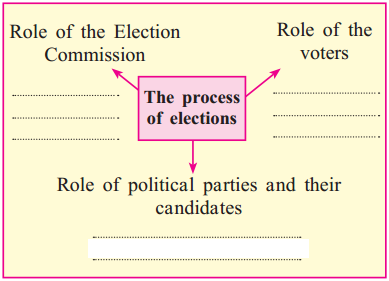
Answer:
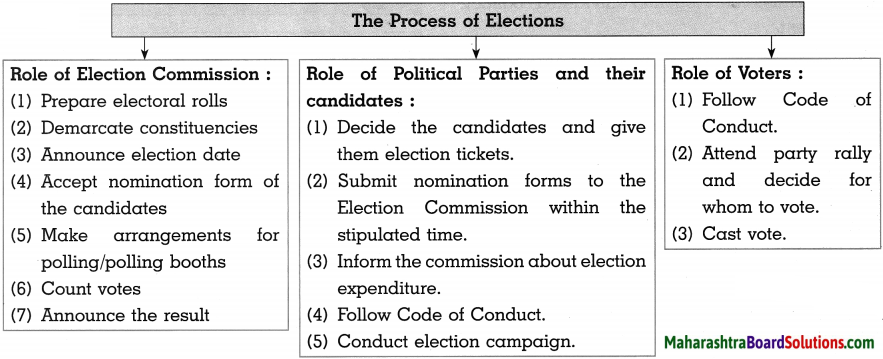
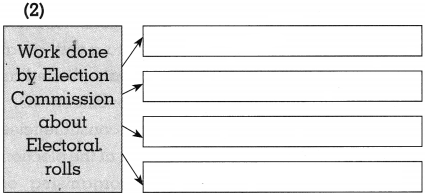
Answer:
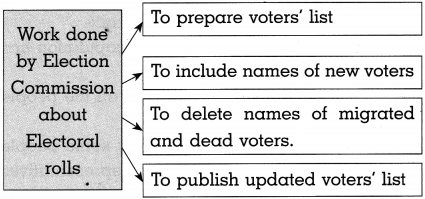
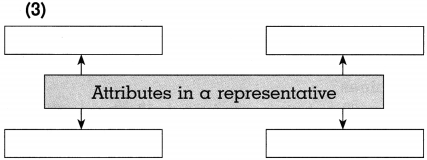
Answer:
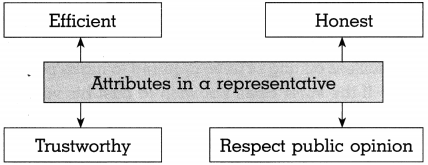
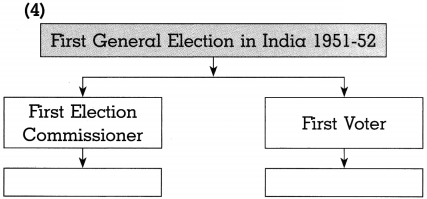
Answer:
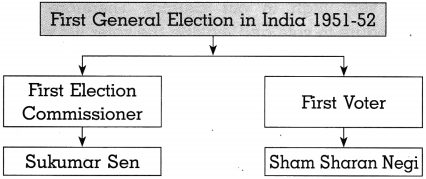
Question 5.
Answer in brief.
(1) Explain the functions of the Election Commission.
Answer:
The functions of the Election Commissipn are:
(1) Prepare the voters’ list.
(2) Decide election timetable and decide the entire process of holding elections.
(3) Scrutinize the applications of the candidates.
(4) Conduct free and fair elections and do all the work related to it.
(5) Give recognition and also de-recognize political parties.
(6) Resolve all the disputes and complaints regarding elections.
(2) Write some additional information about post of the Election Commissioner.
Answer:
(1) The Election Commission in India has one Chief Election Commissioner and two other Chief Commissioners.
(2) All the commissioners are appointed by the President.
(3) The Chief Election Commissioner of India is usually a member of the Indian Civil Service or. Indian Administrative Service.
(4) The responsibility of conducting free and fair elections to the Parliament and State Legislatures lies with the Election Commissioner.
(5) In order do safeguard the independence of the Election Commissioner, he cannot be easily removed from the post for any political reasons.
(3) Explain the meaning of Code of Conduct.
Answer:
(1) After the announcement of elections till the declaration of results, the Election Commission enforces the Code of Conduct.
(2) It explains the rules to be followed by the government, political parties candidates and voters before and during elections.
(3) Code of conduct is adopted to control malpractices during elections. It ensure free and fair ecections.
Project
Organise a mock poll in the school to understand the process of voting.
Answer:
Memory Map
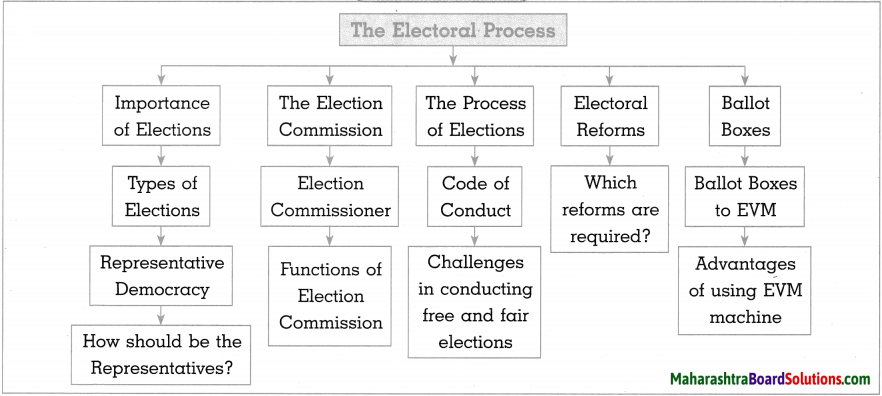
Question 6.
Choose the correct option from the given options and complete the sentences:
(a) Article of Indian Constitution created the independent body of Election Commisšion.
(a) 351
(b) 370
(c) 324
(d) 301
Answer:
(c) 324![]()
(b) system exists in India.
(a) Single-party
(b) Two-party
(c) Multi-party
(d) No-party
Answer:
(c) Multi-party.
(c) The right to give recognition or de-recognize a political party lies with ……………….. .
(a) President
(b) Election Commission
(c) Parliament
(d) Vice-President
Answer:
(b) Election Commission
(d) There are constituencies of Lok Sabha at present.
(a) 288
(b) 350
(c) 500
(d) 543
Answer:
(d) 543
(e) from the present state of Himachal Pradesh was the first voter.
(a) Sukumar Sen
(b) Sham Sharan Negi
(c) Prem Kumar Ghumal
(d) P N. Chadda
Answer:
(b) Sham Sharan Negi
(f) Due to EVM, people can also vote easily.
(a) elder
(b) salaried
(c) Divyanga
(d) Transgender
Answer:
(c) Divyanga![]()
(g) The first elections in India were held in
(a) 1948-49
(b) 1949-50
(c) 1950-51
(d) 1951-52
Answer:
(d) 1951-52.
Question 7.
State whether following statements are True or False. Give reasons for your answer :
(a) There should be secrecy in Election process.
Answer:
The above statement is False. Reasons :
(b) The Election Commission has started awareness campaign for registration of voters.
Answer:
The above statement is True. Reasons :
(c) Every candidate who fills the nomination form can contest election.
Answer:
The above statement is False. Reasons :
Therefore, it is not possible for every candidate who fills the nomination form to contest election.![]()
(d) Sometimes, the Election Commission has to conduct mid-term elections. OR Explain the concept : Mid-Term Elections.
Answer:
The above statement is True. Reasons :
Question 8.
Explain the following concepts :
(a) What is representation?
Answer:
Modern democracy is a representative democracy. In a democracy it is not possible to involve the entire population in the ecision-making process. This resulted in the starting of the practice of electing some people on behalf of entire population
as representatives who would run the government. The representatives who form the government are expected to be responsible to the people and give preference to the welfare of the people.
(b) Election Commission :
Answer:
In India, the Election Commission is central to the process of elections. Art. 324 of the Indian Constitution has established this autonomous body which consists of one Chief Election Commissioner and two other commissioners.![]()
Question 9.
Write short notes :
(a) Journey from Ballot box to EVM machine :
Answer:
(b) Recognition to Political Parties :
Answer:
Question 10.
Complete the concept map :
(a) Prepare a flow chart on the process of election.
Answer:
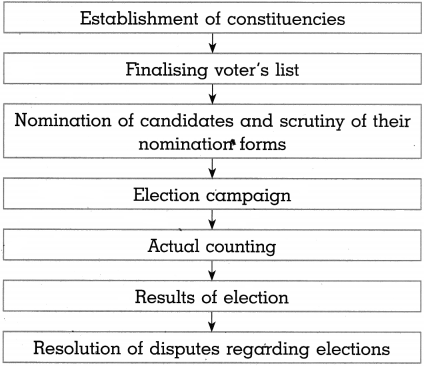
![]()
(b) Which two conditions among following is the violation of code of conduct?
(1) The candidate distributes items of household use. –
(2) Promises made to resolve the water problem if elected.
(3) To go from door to door to meet voters and request them to vote.
(4) To appeal on the basis of caste and religion to get support.
Answer:
(1) The candidate distributes items of household use.
(2) To appeal on the basis of caste and religion to get support.
Question 11.
Answer in brief :
(a) Why is it important to conduct elections?
Answer:
It is important to conduct elections because of the following reasons :
(b) What are the conditions for voting?
Answer:
The following are the conditions for voting:
(c) What action is taken by the Election Commission if disputes arise regarding elections?
Answer:
(d) What challenges are faced by the Election Commission to conduct free and fair elections?
Answer:
The following challenges are faced by the Election Commission tcx conduct free and fair elections :![]()
(e) What are the advantages of EVM machines?
Answer:
The battery operated Electronic Voting Machine (EVM) has more advantages than the ballot box. They are as follows :
(f) Explain the features of procedures of voting during the first Lok Sabha Election.
Answer:
Question 12.
Give your opinion :
(a) When candidates have only the condition of age, why should they give other information to Election Commission? Answer:
(b) Why is it so?
(A) Some constituencies are reserved for scheduled castes and scheduled tribes.
Answer:![]()
(B) Why every political party has an election symbol?
Answer:
(C) At the time of voting and counting of votes, the official representatives of political parties remain present.
Answer:
(D) All recognised parties should get an equal opportunity to express their opinion on media such as television and radio.
Answer:
(c) Think!
(A) How political parties suffer due to family monopoly in the party? OR What are the disadvantages of dynasty rule?
Answer:
(B) What do you understand by the system ‘One Vote One Value’?
Answer:![]()
(d) Voting is our duty as well as responsibility to vote.
Answer:
(e) What measures should be taken to increase the credibility of elections?
Answer:
To increase the credibility of elections the following measures should be taken :![]()
(f) Which rules would you include in Code of Conduct for voters?
Answer:
The following rules should be included in Code of Conduct for voters :